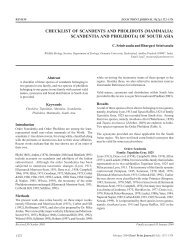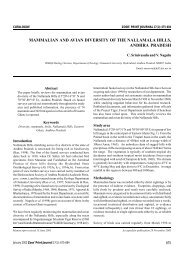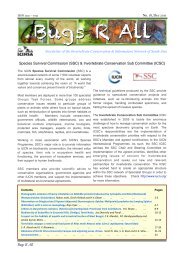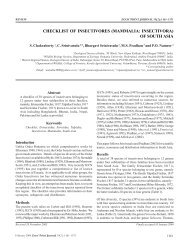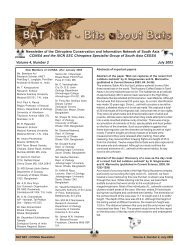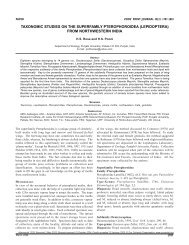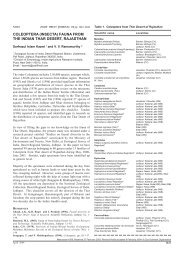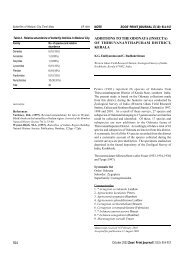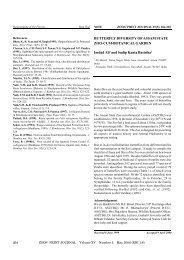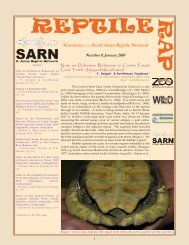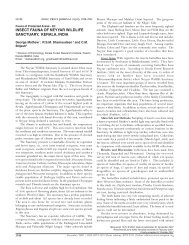Jameela Beevi Danio.pmd - zoos' print
Jameela Beevi Danio.pmd - zoos' print
Jameela Beevi Danio.pmd - zoos' print
You also want an ePaper? Increase the reach of your titles
YUMPU automatically turns print PDFs into web optimized ePapers that Google loves.
CASE REPORT ZOOS' PRINT JOURNAL 18(6): 1111-1112<br />
DANIO FRASERI HORA AND MUKERJI (PISCES: CYPRINIDAE):<br />
A NEW REPORT TO KERALA AND SOUTHERN WESTERN GHATS<br />
K.S. <strong>Jameela</strong> <strong>Beevi</strong> 1 and A. Ramachandran 2<br />
1 Department of Zoology, Maharaja’s College, Ernakulam, Kerala 682011, India.<br />
2 School of Industrial Fisheries, Fine Arts Avenue, Cochin University of Science and Technology, Cochin, Kerala 682016, India.<br />
Emails: 1 ksjameela@ yahoo.com; 2 ram-alappat@eth.net<br />
Abstract<br />
While conducting surveys for potential ornamental<br />
fishes in the fresh water bodies of the river Periyar, three<br />
specimens of <strong>Danio</strong> fraseri Hora and Mukerji, were<br />
collected from a stream joining to the river Periyar, at<br />
Desom, near Alwaye on 6 October 2001. It is the only<br />
species so far known under the genus <strong>Danio</strong> with a<br />
hypertrophied lower lip forming a loose flap along the<br />
lower jaw. This is a new locality record for Kerala and<br />
southern Western Ghats.<br />
Keywords<br />
<strong>Danio</strong> fraseri, new locality record, Periyar, Cochin,<br />
Kerala and southern Western Ghats<br />
Abbreviations<br />
A - Anal fin rays (2 to 3 unbranched rays and 16 branched<br />
rays)<br />
C - Caudal fin rays- 19<br />
D - Dorsal fin rays (2 unbranched rays and 13 branched<br />
rays)<br />
Ll - Lateral line scales: 36-38.<br />
Ll/D - Scales in the lateral line to dorsal fin base: 8<br />
Ll/V - Scales in the lateral line to ventral fin base: 1½.<br />
L tr. - Lateral transverse scales: 9 ½ to 10½;<br />
P - Pectoral fin rays (1 unbranched rays and 11 to 13<br />
branched rays)<br />
V - Ventral fin rays (1 unbranched rays and 7 branched<br />
rays)<br />
Introduction<br />
During the course of a survey on potential ornamental fishes in<br />
the fresh water bodies of Periyar, in Ernakulam District, Kerala,<br />
specimens of <strong>Danio</strong> sp were collected along with other fishes.<br />
The fishes were identified as <strong>Danio</strong> fraseri Hora and Mukerji<br />
Manuscript received 26 April 2002; Revised received 7 March 2003; Finally accepted 30 April 2003<br />
June 2003 Zoos' Print Journal 18(6): 1111-1112<br />
and confirmed by the Zoological Survey of India. A review of<br />
the literature showed the distribution of <strong>Danio</strong> fraseri in Deolali,<br />
Nasik District, Maharashtra. Hora and Mukerji (1935); Fraser<br />
(1942); Barman (1983, 1991); Talwar and Jhingran (1991); Singh<br />
and Yazdani (1993); Jayaram (1981 and 1999).<br />
Reports of Barman (1991) and Singh and Yazdani (1993) showed<br />
the presence of D. fraseri in the Nasik District of Maharashtra,<br />
even recently. But, its occurrence extending to southern Western<br />
Ghats or to Kerala has not been reported so far.<br />
Materials and Methods<br />
<strong>Danio</strong> specimens measuring 53mm standard length (SL) were<br />
collected by using scoop net from a fast flowing wide stream in<br />
Madathumoola, joining to the River Periyar, at Desom, near<br />
Alwaye, Cochin, in Kerala State on 6 October 2001. Water in<br />
the stream was clear with mud, sand and boulders in the bottom,<br />
with a pH of 7.2, temperature 27.2 0 C and salinity zero. There<br />
were plants like Echornia, Pistia and Red Cabamba. Fishes<br />
were fixed in 10% formalin for identification. Measurements<br />
were taken to the nearest 0.1mm by using a dial calipers. Data<br />
are presented as percentages. For the confirmation of the<br />
identification, fishes were sent to the Zoological Survey of India,<br />
Chennai.<br />
<strong>Danio</strong> fraseri Hora and Mukerji<br />
Systematic position<br />
Super Order - Ostariophysi<br />
Order - Cypriniformes<br />
Family - Cyprinidae<br />
Sub family - Rasborinae<br />
Distribution<br />
India: Nasik District, Bombay, Maharashtra; Alwaye, Ernakulam<br />
District, Kerala.<br />
1111
<strong>Danio</strong> fraseri Hora & Mukerji (Pisces: Cyprinidae): a new report to Kerala ... K.S.J. <strong>Beevi</strong> & A. Ramachandran<br />
Diagnostic features<br />
D ii / 13; P i / 11- 12; V i / 7; A ii-iii / 16; C 19. Ll - 36-38; L tr. 9 ½<br />
- 10½; Ll / D: 8 & Ll / V: 1½. Body elongate, its depth 30.2% of<br />
Standard Length (SL) and laterally compressed. Head small, its<br />
length 28.3%, depth 24.5 % of SL. Mouth small, obliquely<br />
directed upwards; lower lip hypertrophied forming a loose flap<br />
along lower jaw, the upper lip normal. This specific character<br />
separates this fish from other <strong>Danio</strong> species. Snout 26.7 % of<br />
head length (HL); eyes large and 33.3 % of HL. Barbels two<br />
pairs, rostral pair longer and extends up to the maxillaries, the<br />
maxillaries small and stump like. Fins hyaline. Predorsal length<br />
54.7, prepectoral length 30.2, preventral length 69.8 and preanal<br />
length 62.2% of SL. Scales large with bluish black dots. Lateral<br />
line complete with 38 scales; lateral transverse rows of scales<br />
9½ to 10½; lateral line to dorsal 8; lateral line to pelvic 1½ and<br />
lateral line to anal 1½ to 2. Pre dorsal scales 16.<br />
Colour: In life - back of the body brilliant blue and belly silverywhite.<br />
Three blue longitudinal lines alternating with golden<br />
yellow lines extend along the whole length of the body. The<br />
middle one is the longest. It is deeply coloured in the caudal<br />
peduncle. The colour extends up to the tip of the caudal fin<br />
rays. The yellow lines are broken down into small loops and<br />
dots in the anterior region. A dark spot is present at the superior<br />
margin of the gill opening. Scales are with shining bluish-black<br />
dots.<br />
Remarks<br />
Comparative analyses of features of <strong>Danio</strong> fraseri with other<br />
<strong>Danio</strong>s like <strong>Danio</strong> malabaricus and <strong>Danio</strong> aequipinnatus<br />
showed similarity in colour and appearance. They all live in<br />
fast flowing water bodies in groups in different areas, but we<br />
could not collect more than one species from the same locality.<br />
<strong>Danio</strong> fraseri differs from them in having the hypertrophied<br />
lower jaw, longer rostral barbels (rudimentary in <strong>Danio</strong><br />
malabaricus and <strong>Danio</strong> aequipinnnatus); small and stump like<br />
maxillary barbels (vestigial in <strong>Danio</strong> malabaricus and <strong>Danio</strong><br />
aequipinnnatus); presence of tubercles on snout and in 38<br />
lateral line scales.<br />
Specimens of <strong>Danio</strong> fraseri collected from Periyar showed<br />
differences from the specimens reported by Barman (1991) in<br />
having head length (HL) equal to fork length (FL); narrower<br />
body and the lateral transverse scales.<br />
Acknowledgements<br />
The authors are grateful to Dr. C. Hridayanathan, Director,<br />
School of Industrial Fisheries, Cochin University of Science<br />
and Technology, Cochin for giving the necessary facilities for<br />
the completion of the work. Sincere gratitude to Dr. K. Rema<br />
Devi, Scientist, Zoological Survey of India, Southern Regional<br />
1112<br />
Station, Chennai, for confirming the identification.<br />
References<br />
Barman, R.P. (1983). A new species of the genus <strong>Danio</strong> Hamilton<br />
from India (Pisces: Cyprinidae). Current Science 52(4): 177-178.<br />
Barman, R.P. (1991). Revision of the species of <strong>Danio</strong>. Records of<br />
the Zoological Survey of India. Miscellaneous publication: Occasional<br />
paper. No. 137: 44-47.<br />
Fraser, A.G.L. (1942). Fish of Poona. Part: 1. Journal of the Bombay<br />
Natural History Society 43(1): 79-91.<br />
Hora, S.L. and D.D. Mukerji (1935). Notes on the fishes in the<br />
Indian Museum -- XXV: on two new cyprinid fishes from Deolali,<br />
Nasik District, Bombay Presidency. Records of Indian Museum 37:<br />
375-380.<br />
Jayaram, K.C. (1981). The fresh water fishes of India, Pakistan,<br />
Bangladesh, Burma and Sri Lanka: A Hand Book. Government of<br />
India, i-xxii+475pp+13plates.<br />
Jayaram, K.C. (1999). The Fresh Water Fishes of Indian Region.<br />
Narendra Publishing House, Delhi, 471pp.<br />
Singh, D.F. and G.M. Yazdani (1993). Ichthyofauna of Konkan<br />
regions of Maharashtra, India. Records of the Zoological Survey of<br />
India. Occasional paper. No. 145: 11.<br />
Talwar, P.K. and A.G. Jhingran (1991). Inland Fishes of India and<br />
Adjacent Countries, Vol. I, pp.373-379. Oxford and IBH Publishing<br />
Co. Pvt. Ltd.<br />
1cm<br />
Figure 1. <strong>Danio</strong> fraseri Hora and Mukerji<br />
June 2003 Zoos' Print Journal 18(6): 1111-1112




